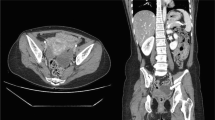Abstract.
A 58-year-old woman was initially externally diagnosed in 1983 with a presacral mass, which was subsequently treated as an abcess. Thereafter, the patient experienced recurrent perianal fistulas. Further diagnostic studies revealed a cystic tumor, considered to be an epidermoid cyst, which was located in the inferior pelvis and was consequently removed. Histologically, cystic scar tissue was found with a highly differentiated adenocarcinoma which measured 4 cm. Later on, the patient again experienced perianal fistulas originating from a renewed presacral mass. As a result, an abdominal-perianal rectum extirpation and a partial resection of the sacrum with placement of a descendostomy were done. Histologically, adenocarcinoma tissue was found at the base of a tail-gut cyst. One year following her operation, the patient is free from any complaints and relapses. The tail-gut cyst is a very rare entity which arises from the inadequate involution of the tail-gut during embryonal development. A malignant transformation occurs in 10 % of the cases. In the case of recurrent perianal fistulas and cystic masses between the rectum and os sacrum or os coccygeum, a tail-gut cyst should be taken into consideration, the goal being its complete removal.
Zusammenfassung.
Bei einer 58 jährigen Patientin wurde 1983 auswärts erstmals eine präsacrale Raumforderung diagnostiziert, die als Absceß behandelt wurde. Im Anschluß daran kam es zu rezidivierenden perianalen Fisteln. Die weitere Diagnostik zeigte einen im kleinen Becken liegenden cystischen Tumor, der als Epidermoidcyste angesehen und entfernt wurde. Histologisch fand sich cystisches Narbengewebe mit einem 4 cm messenden, hoch differenzierten Adenocarcinom. Im weiteren Verlauf kam es erneut zu perianalen Fisteln, ausgehend von einer erneuten präsacralen Raumforderung. Es erfolgte die abdominoperineale Rectumexstirpation und Sacrumteilresektion mit Anlage einer Descendostomie. Histologisch fand sich jetzt Adenocarcinomgewebe auf dem Boden einer Tail-gut-Cyste. Die Patientin ist ein Jahr nach der Operation beschwerde- und rezidivfrei. Die Tail-gut-Cyste ist eine sehr seltene Entität, die aus der ungenügenden Rückbildung des in der Embryonalentwicklung vorhandenen Schwanzdarms entsteht. Eine maligne Transformation wird bei 10 % beschrieben. Rezidivierende perianale Fisteln und cystische Raumforderungen zwischen Rectum und Os sacrum bzw. Os coccygis sollten an eine Tail-gut-Cyste denken lassen, deren vollständige Entfernung anzustreben ist.
Similar content being viewed by others
Author information
Authors and Affiliations
Rights and permissions
About this article
Cite this article
Sauer, J., Wolf, H. & Junginger, T. Adenocarcinom in einer Tail-gut-Cyste Seltene Ursache einer rezidivierenden perianalen Fistel. Chirurg 71, 712–716 (2000). https://doi.org/10.1007/s001040051125
Issue Date:
DOI: https://doi.org/10.1007/s001040051125




